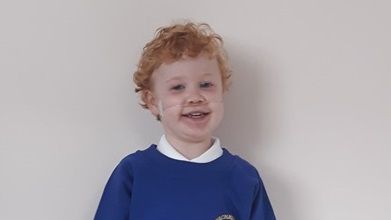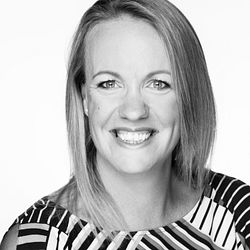
News -
Miracle baby born with half a heart celebrates his first day at school
As he happily shows off his uniform before his first full day at school, it is hard to believe little Kaleb was once given almost no chance of survival.
Before Kaleb was born, his parents Kirsty and Shaun Lewis were told their unborn child had just half a heart.
There was a high risk he would not survive the pregnancy, and if he did, he may not survive the birth or subsequent surgery needed to help him stay alive.
“I didn’t prepare to bring him home,” said Kirsty, aged 37, from Hull. “But I knew I couldn’t terminate the pregnancy. He was so active during my pregnancy that I needed to give him a chance to show just how strong he was.”
Thanks to the skills of a team of doctors and nurses at Birmingham Women’s and Children’s NHS Foundation Trust, Kaleb survived the birth and underwent open heart surgery when he was just minutes old.
Kirsty and Shaun were told their newborn son was unlikely to survive but he miraculously pulled through and despite a string of life-or-death emergencies since he was born, Kaleb has now marked the significant milestone of starting school, which once seemed impossible.

MIRACLE: Kaleb (above), just six hours old and fighting for his life
Kaleb, age four, was given just a one-in-five chance of survival after being diagnosed with a severe heart condition before he was born. He had hypoplastic left heart syndrome with an intact atrial septum, which meant he had half a heart and his blood flowed between the normally-separated heart chambers.“When I saw him in his uniform, I had to pinch myself,” said Shaun, aged 29. “I just kept thinking to myself, how the hell did we get here? It’s a long way from that first day when he was born in hospital.”
He spent the first few months of his life at Birmingham Women’s and Children’s NHS Foundation Trust in a high dependency unit. In January 2015, he was transferred to Leeds General Infirmary for ten days before being admitted to Hull Royal Infirmary and then back to Birmingham.
“Kaleb was in and out of hospital for the first year of his life,” said Kirsty, who gave up her career as a hairdresser to care for Kaleb full-time. “He had his second open heart surgery operation when he was just three weeks old, and his third open heart surgery operation when he was three and a half months old.
“When he was just six months old, Kaleb fell really ill and we were told by the doctors and nurses that he just hours to live and that ‘maybe it was time to let him go’. We were devastated but we couldn’t give up on him, he’d fought so hard already.”
Kaleb thankfully pulled through and the family were given the option to take part in the RAPID (Real-Time Adaptive & Predictive Indicator of Deterioration) Project, a world-leading study using wireless technology developed by UK-based company Isansys Lifecare to predict deterioration in seriously ill children.

MONITORED: Kaleb being monitored with the Patient Status Engine as part of the RAPID Project at the Birmingham Women's and Children's NHS Foundation Trust
Kaleb was one of the first children to be monitored as part of the project with the Patient Status Engine (PSE), a Class IIa CE-marked, and Class II FDA cleared continuous patient monitoring platform and its Lifetouch™ ‘smart patch’ technology.
Kirsty, who has two other children, Kodi, 15, and Korban, eight, said: “Kaleb needed extra monitoring. When he was rushed into intensive care and we were told he had just a couple of hours to live we were devastated. We needed to give him every chance of survival.
“We were told the Patient Status Engine would be able to collect his vital signs including his heart rate, respiration rate and oxygen saturation levels continuously and in real-time. This information would then be used to automatically predict when he was getting poorly. If his health did get worse, the system would provide a warning to both us and the nursing staff so they could act on it immediately.
“There were so many times it picked up deterioration when there were no other signs of Kaleb’s health getting worse. We were new parents and didn’t know the signs to look out for and most of the time he got poorly in between nurse observations, so having the PSE monitoring him was like having an extra pair of eyes watching over him.
“Also because the sensors he wore were wireless we were able to pick him up and cuddle him without getting tangled in loads of wires.”
She said Kaleb’s condition was high risk and for 11 months, they never left his side.
“Every moment in the first year of Kaleb’s life it was a matter of life or death,” said Kirsty. “I didn’t want to leave him and it was only when we started the continuous monitoring that Shaun and I could take it in turns to pop across the hospital into town to grab some food or some bits without worrying that something would happen and one of us wouldn’t be there.
“At night it really helped knowing he was being monitored as Shaun and I could take it in turns to sleep by Kaleb’s side so one of us could rest whilst the other could watch the screen at night and see how he was doing. It gave us the comfort we needed that we wouldn’t have had otherwise.
“The nurses on the wards are so busy and by having Kaleb monitored all the time it meant they didn’t have to write down the observations or carry out manual observations. They could concentrate on the sickest patients.”
There were times when Kirsty was worried about being seen as an erratic mother if she called a doctor or nurse about Kaleb’s health.
“There were so many times before he was monitored with the PSE I had seen his heart rate soar to 280 beats per minute and then drop again but I could never prove it,” she said. “Now I didn’t have to worry about being an erratic, obsessed mother. If I felt something was wrong, I could look at the PSE and see what his vital signs were doing. Often my feelings mirrored the data. I could then speak to a nurse or doctor and explain what was happening and have the proof to show them. I felt so much more in control.”
The three-year project, the first of its type in the world, was jointly funded by a £1.8 million grant from the Wellcome Trust and the Department of Health, through the Health Innovation Challenge Fund. It has now monitored more than 1,300 children and babies and work is progressing to roll-out the technology hospital wide.
After a number of life-threatening illnesses including developing pneumonia, causing his lungs to collapse, and nine major operations Kaleb was finally allowed home in August 2015.
Shaun, who used to work as a builder before Kaleb was born but is also now a full-time carer for his son, said: “We were told to expect the worst when he developed pneumonia, but we took each day as it came and every day he pulled through and got stronger and stronger.”
Now, with his new school uniform and books at the ready, Kaleb is starting his first term at the same Dorchester Primary School as big brother Korban and they are getting ready to go on a family holiday to Butlins, Skegness.
Shaun said: "When Kaleb was born, we prayed every day he would survive. Never in our wildest dreams did we think we’d see him start school or go on holiday. He has proved to us just how strong he is and now we know he can do anything. He’s such a miracle. He loves life and has taught us to appreciate every moment. We’re really just so lucky.”
The family has set up a charity called Kaleb’s Cause to spread awareness of Hypoplastic Left Heart Syndrome and to raise money to help bring families together whilst their sick child is in hospital. More information about the charity can be found at https://m.facebook.com/KalebsCause

